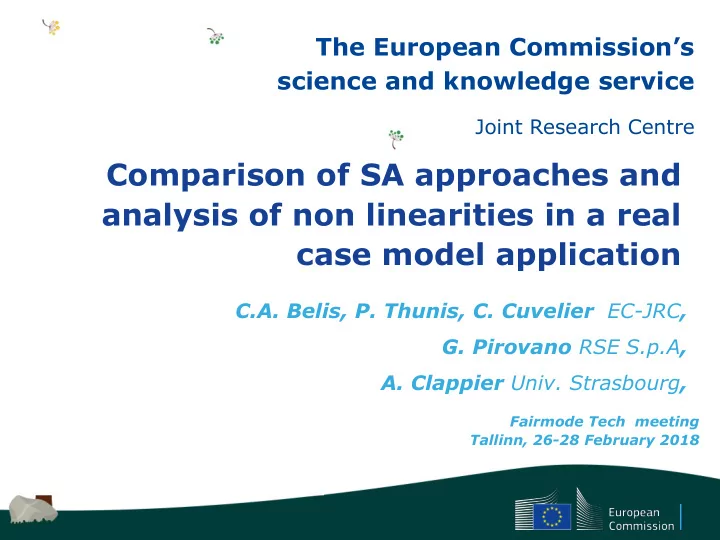

The European Commission’s science and knowledge service Joint Research Centre Comparison of SA approaches and analysis of non linearities in a real case model application C.A. Belis, P. Thunis, C. Cuvelier EC-JRC , G. Pirovano RSE S.p.A , A. Clappier Univ. Strasbourg , Fairmode Tech meeting Tallinn, 26-28 February 2018
Source Apportionment and sensitivity analysis Stein and Alpert decomposition 2 sources ∆𝐷 𝑩𝑪 = ∆𝐷 𝑩 + ∆𝐷 𝑪 + 𝐷 𝑩𝑪 Stein and Alpert decomposition 3 sources ∆𝐷 𝑺𝑩𝑱 = ∆𝐷 𝑺 + ∆𝐷 𝑩 + ∆𝐷 𝑱 + 𝐷 𝑺𝑩 + 𝐷 𝑺𝑱 + 𝐷 𝑩𝑱 + 𝐷 𝑺𝑩𝑱 Strong non-linearity is associated to secondary pollutants deriving from precursors emitted by different sources. We need to understand how often (when, which ones) sources stray from linearity Clappier et al., 2017 2
Simulation with tagged species and Brute Force approaches Experiment Design and data processing by JRC Model: CAMx run by RSE Tagged species module: PSAT Pollutant: PM2.5 Area: Po Valley Reference year: 2010 Time window: full year Domain: 580 x 400 km 2 Grid step: 5 km x 5km approx. Meteorology: WRF 14 layers Emissions: EMEP (Europe), ISPRA (Italy), INEMAR (regional) processed with SMOKE 3
Simulation with tagged species and Brute Force approach Brute force: 3 sources reduced: agriculture, industry and transport Base case 100% reduction of: Scenario 1: M10, • Scenario 2: M34, • Scenario 3 M7, • Scenario 4 M10 and M34, • Scenario 5 M10 and M7 , • Scenario 6 M7 and M34 , • Scenario 7 M10, M7 and M34 • Same scenarios with 50% reduction 4
CAMX SIMULATION PO VALLEY WITH PSAT AND BRUTE FORCE Comparison PSAT and Brute Force approaches • Check interaction terms (of the Alpert algebraic expression) • for every pair of sources Analyse geographical patterns • Analyse influence of time resolution • Examine emissions in support to data analysis • Test behavior in different types of areas (urban, rural, etc.) • 5
CAMX BASE CASE PM10 CONCENTRATIONS 6
CAMX BASE CASE EMISSIONS NH3 EMISSIONS SO2 EMISSIONS SO4 -2 EMISSIONS NOX 7
BF 100%-tagged, Agriculture PM10 AGRICULTURE 8
BF 100%- tagged, Industry PM10 INDUSTRY 9
BF 100%- tagged, Traffic PM10 TRAFFIC 10
BF 100% Interaction terms Agriculture Traffic PM10 AGRI-TRAFF 11
BF Interaction terms Agriculture Traffic PM10 AGRI-TRAFF100% PM10 AGRI-TRAFF 50% 13
BF 100% Interaction terms Agriculture Industry PM10 AGRI-INDU 14
BF 100% Interaction terms Traffic Industry PM10 TRAF-INDU 15
BF 100% Interaction terms Agri. Ind. Traf. PM10 THREE SOURCES 16
Conclusions Tagged species (TS) lower than Brute force (BF) especially in Agriculture • (avg. 70%). Higher differences in rural areas compared to urban ones. Traffic and industry differences are much lower (avg. 5-10%). • Hourly and daily variability very noisy • Non linearity for 50% reduction much lower (1/4) than 100% reduction • The two and three way interactions terms have marked seasonal trends. • The stronger non linearity is in the agriculture - traffic (A-T) interaction • Significant differences between cities and rural (different regimes: NH3 • limited vs NO2 limited?) A-T non linearities (negative) more relevant in summer (NO2 limited?) • In certain cities (NH3 limited?) the seasonal trends compensate leading • to annual average close to zero. 17
Thank you for your attention 18
Recommend
More recommend